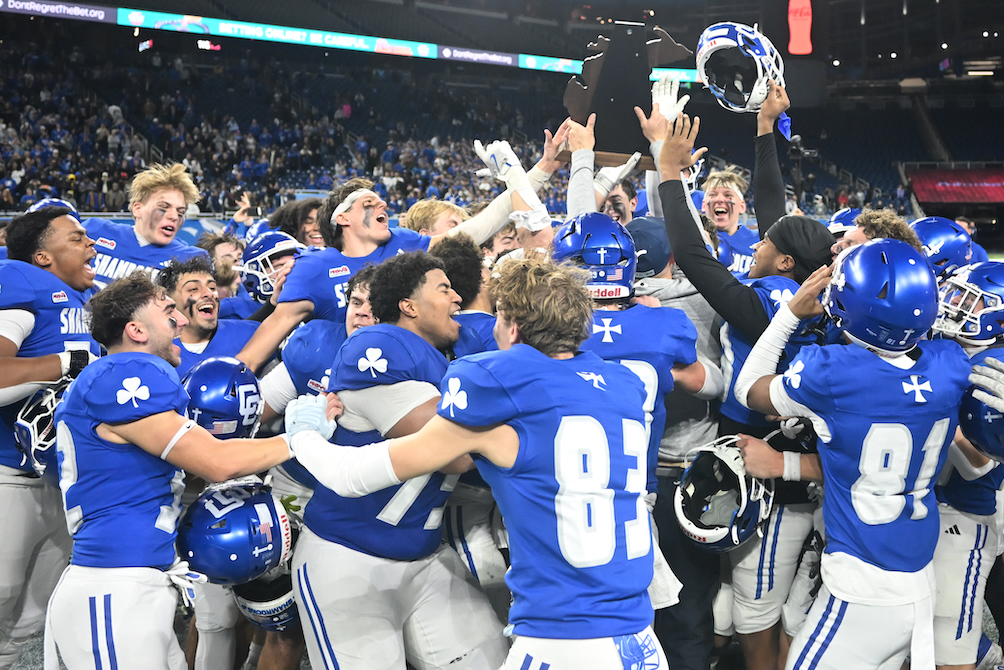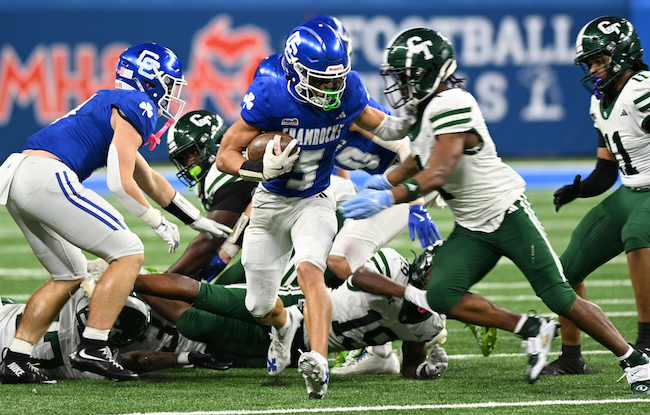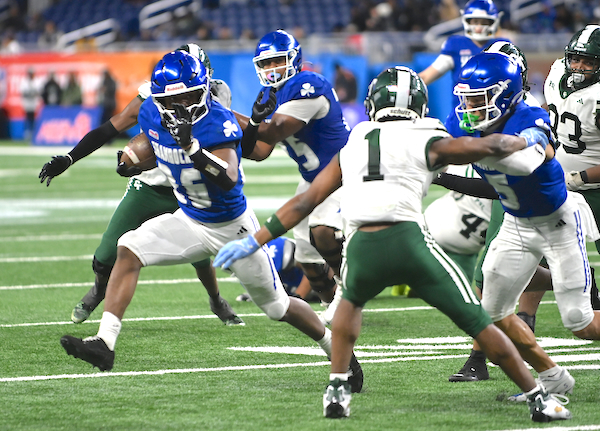
Inside Selection Sunday: Mapnalysis '13
October 28, 2013
By Geoff Kimmerly
Second Half editor
At the end of the day – Sunday, in this case – the 2013 MHSAA football playoff field was determined based on a set of numbers we began working with long before the first kickoff of this season.
So to kick off our discussion of how some of the 2013 playoff-selection decisions were made, here are a few numbers that might boggle the mind – or at least surprise:
- A total of 3,111 high school results were used in determining this season’s field – 2,978 for 11-player and 133 for 8-player games.
- We inputted and then followed the schedules for 623 MHSAA teams.
- We also inputted and followed weekly the schedules for 50 teams from surrounding states and Ontario that played at least one game against one of our MHSAA schools.
- We worked through complicated maneuverings made necessary by seven teams playing a mix of 11 and 8-player games, plus two more teams that played a mix of varsity and junior varsity opponents.
- And by Sunday morning we ended up with a few more numeric rarities: only 225 automatic qualifiers, the fewest since the current playoff system was introduced in 1999, and also an uneven number of at-large bids from our four classes because only six Class D teams reached the number of victories needed to be considered. (This was balanced by taking more at-large qualifiers from Classes A, B and C.)
And that was just the start of one of our most exciting days of the school year.
Following are more details. First, I explain some of the history of the MHSAA playoffs – I’ve lifted this in part from our 2012 report, so skip ahead if you’ve already got that down. Next, I touch on five themes that emerged as we built the brackets for this season’s tournament.
The process
Our past: The MHSAA playoff structure – with 256 teams in eight divisions, and six wins equaling an automatic berth (or five wins for teams playing eight or fewer games) – debuted in 1999, as mentioned above. An 8-player tournament was added in 2011, resulting in nine champions total when November is done.
That’s a long way from our start. The first playoffs were conducted in 1975 with four champions. Four more football classes were added in 1990 for a total of eight champions each fall. Through 1998, only 128 teams made the postseason, based on their playoff point averages within regions (four for each class) that were drawn before the beginning of the season. The drawing of Districts and Regions after the end of the regular season did not begin until the most recent playoff expansion.
In early years of the current process (or until the middle of the last decade), lines were drawn by hand. Dots representing qualifying schools were pasted on maps, one map for each division, and those maps were then covered by plastic sheets. Districts and Regionals literally were drawn with dry-erase markers.
Our present: After a late Saturday night tracking scores, we file in as the sun rises Sunday morning for a final round of gathering results we may still need (which can include making a few early a.m. calls to athletic directors). Then comes re-checking and triple-checking of enrollments, what schools played in co-ops, some records and more before the numbers are crunched and the fields are set.
Those 256 11-player teams are then split into eight equal divisions based on enrollment, and their locations are marked on digital maps that are projected on wall-size screens and then discussed by nearly half of the MHSAA staff plus a representative from the Michigan High School Football Coaches Association. Only the locations themselves are marked (by yellow dots) – not records, playoff point averages or names of the schools or towns. In fact, mentions of those are strictly prohibited. Records and playoff points are not part of the criteria. Matchups, rivalries, previous playoff pairings, etc. also DO NOT come into play. The same process is followed for organizing the 8-player bracket.
Observations and answers: 2013
This doesn’t happen overnight: Preparation for selecting the MHSAA playoff field begins long before the first kickoff of fall, much less the first practice. We load schedules for all 600-plus varsity teams during the summer, and many schedules remain fluid right up until the first Friday of the season – and this fall, a few weren’t settled until Week 2 or 3.
This summer as in some past we also worked through schools closing (Inkster, Saginaw Buena Vista, Detroit Northwestern, Flint Northern), and others deciding in mid-July and early August they would not field teams because of a lack of players.
Sometimes we have to take odd paths to find scores for these games. The last 11-player score to be added to our data this regular season came in as a result of tweeting the sports anchor of a Wheeling, W.Va., television station. Our last 8-player score came in via email from a Wisconsin athletic director at 10:30 Saturday night. Thankfully, we get plenty of assistance from some of our friends in the field, who keep an eye on the data and alert us when something appears missing or incorrect.
Win and advance: This season’s list of 5-4 teams includes a number of heavy hitters that did not receive at-large bids – East Grand Rapids, Utica Eisenhower, Orchard Lake St. Mary’s and Flint Powers Catholic to name a few. All were solid teams and played strong competition. All missing the playoffs likely raised some eyebrows.
But we have to take a look at this from a statewide view. There admittedly can be some argument about what schools qualified for the 226-256 spots in the field – but the important part is that 225 qualified because they all met the minimum win requirement. A playoff is simply that – it decides a champion based on teams winning. For some it’s harder to pile wins, of course, because they play in tough leagues. But the winners of those leagues are in the field – and surely will credit that tough road with getting them prepared to now play the state’s best.
Geography rules: This long has been rule number one for drawing MHSAA brackets in any sport, and is a repeat as well for those who have read this report the last two Octobers. Travel distance and ease DO come into play. Jumping on a major highway clearly is easier than driving across county-wide back roads, and that’s taken into consideration.
Also, remember there’s only one Mackinac Bridge and hence only one way to cross between peninsulas – and boats are not considered a possible form of transportation. When opponents from both peninsulas will be in the same District, distance to the bridge is far more important than as the crow flies.
The best example of this comes this season in Division 5. Grayling clearly is east of both Kingsley and Kalkaska – but also sits on I-75, while those two do not. So while those more western teams are geographically closer to Houghton, Menominee and Kingsford from the Upper Peninsula, we instead paired the three U.P. teams with Grayling because being on a main highway made for a shorter trip. The trip to Grayling for any of those U.P. teams would be 36 miles shorter to Grayling than Kingsley and 13 miles shorter to Grayling than Kalkaska.
Sometimes it’s where the points aren’t: Sure, it would be best-case scenario to have perfect sets of eight dots split into four quadrants from Calumet to Bedford. But generally that doesn’t occur. “Dots determine the map” is a common phrase heard here during this selection process, but that works the other way as well. If there are no qualifiers in a division from a specific area of the state – see Division 1, with none south of Holland or west of the greater Lansing area – there’s no choice but to create the unusual Regional Final possibility of Traverse City West vs. Brighton. Brighton is simply closer to the west side of the state than our other options.
Border to border vs. coast to coast: Should Regions be grouped north to south or east to west? There isn't a right or wrong answer – it just depends on that set of dots.
Whenever we have Upper Peninsula teams in a division, they’ll be grouped with those from the northernmost points of the Lower Peninsula for a District. The next northernmost schools will be grouped into a District, and together those eight will form a Region.
But the tough decision comes with the other six Districts. Look at this season’s Division 5 map: Six Districts are grouped south of U.S. 10 with three near or west of U.S. 127 and three east of that highway, which runs through the center of the Lower Peninsula. We grouped the two southwestern Districts into a Region and the two southeastern Districts into a Region – leaving a final Region that stretches from Muskegon on Lake Michigan to Almont, about 35 miles west of Lake Huron.
That’s a haul. But it’s also the best of our possible compromises. We could’ve instead paired regions that would’ve stretched from Hopkins to Monroe – only 19 fewer miles in distance than Muskegon Oakridge to Almont, but a scenario that could’ve created travel increases for a number of additional teams. Another option included a possible trip from Detroit University Prep to Freeland, which also would take more than two hours.
Bottom line – it’s been written here before – we pour all we have into this process, asking questions often more than once until we come up with a consensus. We do appreciate the arguments that arise once brackets are released to the public: The discussions are proof of how much players, coaches and fans care – and often show us new ways we can look at a system that’s now 15 years old.
But we must remember that the good news is the tournament is still set up to reward nine champions over the next five weeks, and five schools – Auburn Hills Oakland Christian, Coldwater, Detroit Allen, Eaton Rapids and Muskegon Mona Shores – will be competing for those titles for the first time.
It’s not so much how the tournament starts as how it ends. And we’re preparing for nine more memorable conclusions.
PHOTO: Each collection of grouped dots is a District on this season's Division 3 playoff map.

DCC Closes Season by Avenging 2024 Semifinal Loss to 'Finish What We Started'
By
Scott DeCamp
Special for MHSAA.com
December 1, 2025
DETROIT – The featured matchup of 2025 MHSAA Football Finals weekend at Ford Field pitted unbeaten heavyweights Detroit Catholic Central and Detroit Cass Tech in the Division 1 title bout.
DCC coach Justin Cessante used a boxing metaphor with his team in the days leading up to the main event. The Shamrocks essentially won by unanimous decision, although a knockout punch came from an unlikely source.
A 61-yard pick-6 by 6-foot-3, 300-pound senior noseguard Benny Eziuka with 3:12 remaining got the party started early and put the finishing touch on DCC’s dominant 42-19 victory over reigning champ Cass Tech to close Sunday night.
“We had a theme all week that our special teams and run game are going to be the body shots,” Cessante said. “Our uppercut is going to be making big plays on offense, and our defense – brick wall – was going to be the head shots.
“We talked about that all week and how we were going to play a physical, disciplined brand of football. I think we did that in all three phases.”
DCC did just that in capping a 14-0 season and capturing its first Finals title since 2009. The Shamrocks, who made their first championship game appearance since 2016, now have 11 wins in 18 trips to the final round.
Cass Tech (13-1) outgained DCC, 358-311, but the Shamrocks’ stingy defense forced multiple Technicians miscues, including two interceptions and a lost fumble.
Cass Tech suffered only its second Finals defeat in six overall trips to the championship game.
 “We left a lot of stuff on the field,” Cass Tech coach Marvin Rushing said. “We’ll come back in a couple weeks and watch some of this stuff and we’ll be pounding the table a little bit with some of the stuff that we left on the field.
“We left a lot of stuff on the field,” Cass Tech coach Marvin Rushing said. “We’ll come back in a couple weeks and watch some of this stuff and we’ll be pounding the table a little bit with some of the stuff that we left on the field.
“To be a champion, you’ve got to beat the man to be the man today. They get to hoist the trophy, and they deserve it.”
DCC junior quarterback Duke Banta and classmate Gideon Gash connected on three touchdown passes: 41 yards with 7:44 left in the first quarter, 37 yards with 7:36 left in the third, and 48 yards with 4:52 remaining in the contest.
Banta finished 9-of-11 passing for 156 yards and no interceptions. All three of Gash’s receptions went for scores. Older brother, senior Samson Gash, had five receptions for 25 yards.
DCC senior Cedric Williams led all rushers with 72 yards on 18 carries with a one-yard TD midway through the fourth quarter. Senior Joshua Peters scored on a five-yard run to give the Shamrocks a 13-0 lead late in the first half, while junior kicker Ty Goddard booted a 21-yard field goal early in the fourth quarter for the champions.
It was Eziuka who stole the show, however. The two-way starting lineman and Penn State commit realized a big man’s dream. Junior linebacker Jalen Montlouis pressured Cass Tech’s backfield near the Technicians’ 45-yard line and forced a risky throw, which Eziuka caught at his own 39. Eziuka got a couple blocks, rumbled down the DCC sideline, and stomped into the end zone to the roar of the crowd.
“You know, I was just in the right place at the right time. I caught the ball, my teammate Connor Ryan was throwing me a block, so I was like, ‘I mean, he made the effort, so I’ve got to try to score,’” Eziuka said. “You know, I made the cut and saw green grass. I was like, ‘That’s a long way, but I’ve got to try.’ I kept going. I saw one of their guys catching up to me. My teammate, Jack Janda, made a great block for me to get in there.
“When I was in the end zone, I had to make my way to the barrier because I was not standing up for very long. (The barrier) was supporting me. I definitely needed oxygen,” Eziuka added with a chuckle. “It was a great play for the entire team.”
Samson Gash was asked if he felt threatened by Eziuka and a potential claim of being fastest player on the team.
“A little bit. Low key, a little bit,” Gash said to laughter in the interview room.
In addition to its interceptions, DCC’s defense sacked talented sophomore quarterback Donald Tabron II three times and limited Cass Tech to 73 rushing yards. Tabron finished 25-of-37 for 285 yards with two TDs – one to senior Corey Sadler Jr. from 15 yards out with 5:24 left, and the other to senior William Sykes Jr. from 12 yards out with 14 seconds remaining.
 Sadler, a North Carolina commit, wrapped up his storied four-year varsity career with 11 receptions for 130 yards and made a co-team-high seven tackles.
Sadler, a North Carolina commit, wrapped up his storied four-year varsity career with 11 receptions for 130 yards and made a co-team-high seven tackles.
“The four years have been great,” Sadler said. “I’m probably one of the best players to come through Detroit in the PSL league, so … it was a sad outcome today. You know, college is next. I just have to keep my head high. We fought. CC had a great game.”
Senior Justin Bonner also made seven stops for Cass Tech. For DCC, Montlouis led the way with eight tackles.
Sunday’s victory also represented a measure of revenge for DCC, which fell to Cass Tech in last year’s Semifinals, 17-14.
In the 2016 Final, the Shamrocks fell to the Technicians, 49-20.
“It’s a tremendous feeling,” said Cessante, who capped his fourth year leading DCC’s program. “Other than being married and my children, bringing a championship back to my alma mater, Detroit Catholic Central, where this championship belongs, obviously against a team (where) we just had enough over the years in regards to the rivalry that’s been built and them being really a nemesis and us getting over the hump and finishing what we started (is special).”
The Gash brothers have been double trouble for DCC opponents.
While it was Gideon’s turn to shine Sunday, the siblings reflected on what it means to share in the Shamrocks’ long-awaited championship and how special it was to share in it.
“It means everything to us. After we lost last year to Cass Tech, we knew we should have beat them. But like Coach Cessante said, we didn’t prove it,” Samson Gash said. “Our motto this year was, ‘Finish what we started.’
“Our seniors did a great job last year, and we needed to bring a state championship for this year and just working every single day with my brothers, my best friends for life, it means everything to us to go out on top, for sure.”
PHOTOS (Top) Detroit Catholic Central players celebrate Sunday while hoisting their championship trophy. (Middle) The Shamrocks’ Samson Gash (5) attempts to put space between himself and a Cass Tech defender. (Below) Cedric Williams (26) picks his path as Gash blocks in front of him.

